A Deep Dive into Bifold Closet Doors Dimensions
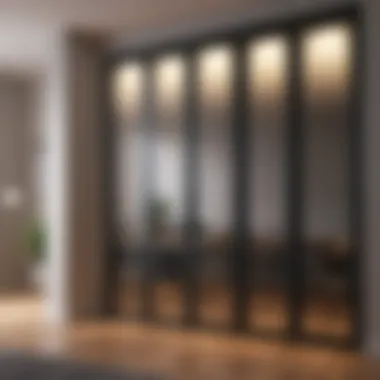

Intro
When it comes to sprucing up your home, every detail counts, right? Enter bifold closet doors, seemingly simple, yet they pack a punch in both style and function. These doors, typically characterized by their folding mechanism, can transform a cramped closet into an efficient storage solution that blends seamlessly with your space.
Understanding the dimensions, particularly the common size of 29.5 x 79 inches, is crucial when planning to integrate bifold doors into your home. This specific measurement isn’t just a random figure; it’s like a sweet spot that works well in many settings, whether for residential nooks or commercial storage solutions. And let's not forget, the importance of design here! Bifold doors are available in a multitude of materials and styles, allowing you to choose an option that suits your home’s aesthetic.
By learning about bifold closet doors in depth, you're not just making a cosmetic upgrade; you're enhancing functionality, maximizing space, and ensuring that your choices reflect a thoughtful approach to home improvement.
Preamble to Bifold Closet Doors
Bifold closet doors are more than just a functional element in your home; they embody a blend of style, space-saving utility, and versatility. As homes become more complex, with limited space and a need for efficient organization, the choice of doors impacts both aesthetics and practicality. This section focuses on the pivotal role of bifold doors, examining their very essence and benefits.
Definition and Purpose
So, what exactly are bifold doors? Simply put, they are a type of door that consists of two panels hinged together, allowing them to fold and slide open or closed. They are ideal for closets or spaces where traditional swinging doors would take up too much room. Whether you're dealing with a small bedroom or a wide hallway, bifold doors cleverly utilize available space.
Their primary purpose centers on accessibility. When you want to access your closet, these doors make it a swift and effortless act. Instead of neatly sidestepping past swinging doors, you can glide these panels aside, granting you complete access.
Not just confined to closets, these versatile doors can also be found in laundry rooms or as space dividers. This adaptability speaks volumes about their functionality, appealing to both practical homeowners and design enthusiasts.
Benefits of Bifold Doors
Bifold doors offer a myriad of advantages that make them a worthy consideration for any homeowner. Here are some key benefits:
- Space Efficiency: Their unique folding mechanism requires less space than traditional doors, making them perfect for tight areas.
- Aesthetic Appeal: Available in a variety of styles and finishes, bifold doors can elevate the overall look of your home. From wood grain to sleek glass, there’s a design to suit any interior.
- Enhanced Light Flow: Bifold doors can combine the beauty of natural light with functional utility. Opened fully, they can make a room feel brighter and more spacious.
- Cost-Effective: Compared to other door types, bifold doors often come at a more manageable price point. The affordability doesn’t sacrifice style or function.
- Easy Maintenance: Most materials used for bifold doors require minimal upkeep. A quick wipe-down and some lubrication on the hinges can keep them operating smoothly for years.
"Bifold closet doors are not just an entryway; they are a gateway to maximizing your home's potential."
Understanding these elements allows homeowners, especially those juggling busy families or cramped spaces, to see the true value in bifold door installations. The upcoming sections will dive deeper into the specifics—sizing, materials, installation, and more—ensuring you are fully equipped to make the best decisions for your home.
Understanding Dimensions: 29. x
The dimensions of bifold closet doors, particularly 29.5 x 79 inches, hold significant weight in the overall functionality and aesthetic of a space. The right measurements ensure not only a seamless fit but also create a balanced visual impact within your home. This sizing is tailored to standard openings, making it a go-to choice for homeowners looking to maximize both accessibility and style.
Importance of Sizing in Door Selection
Getting the size right is more than just a formality; it can be make or break in your design plan. When one opts for a bifold door that doesn’t fit correctly, it’s akin to wearing shoes two sizes too small. The door won’t swing open properly, it may end up jamming, and over time, this could lead to damage or inefficiency.
Here’s what to keep in mind when considering sizing:
- Functionality: A door that fits like a glove allows for easy access to your closet. You don’t want to fiddle with your door every time you need to grab something inside.
- Visual Appeal: A properly sized bifold door aligns well with the rest of your interior design. Mismatched dimensions can create visual chaos, distracting from your meticulously designed space.
- Installation Convenience: Standard sizes like 29.5 x 79 inches simplify the installation process, saving you time and potential headaches in adjusting trim or making cumbersome modifications to your wall structure.
- Airflow and Light: A correctly dimensioned door enhances airflow and light quality in the room. A door that is too large can block light and create a cramped feel, whereas one that’s properly sized can open the space up.
In essence, having bifold doors that measure 29.5 x 79 inches is about crafting an integrated appearance while avoiding functional pitfalls.
Common Applications for Bifold Doors
Bifold doors really shine in various settings, proving their versatility. They are more than just functional structures; they have a talent for breathing new life into environments. Let's explore some typical scenarios where bifold doors are advantageous:
- Closets: Of course, this is their chief domain. Utilizing the bifold design allows for better use of space, especially in smaller rooms. They fold up neatly, avoiding the swing space required by hinged doors.
- Pantries: Bifold doors aren’t just for closets; they fit right in when securing pantry spaces too. They let you access items quickly and can handle diverse storage requirements—think of all those bags of flour and sugar!
- Laundry Rooms: Having a bifold door leading to your laundry area can hide appliances neatly while maintaining space efficiency. No more clunky full-length doors blocking your path.
- Room Dividers: When looking to create an open feel but still maintain some separation, bifold doors serve as excellent room dividers. They allow for flexible space usage without entirely closing off an area.
Important Note: When choosing bifold doors for any application, ensure you take accurate measurements of the opening. Small errors can lead to significant issues.
In summary, the dimensions of bifold doors—specifically 29.5 x 79 inches—are vital to convenience and style. Their use across closets, pantries, and beyond only enhances their appeal, encouraging homeowners to make informed selections that reflect both their needs and aesthetic desires.
Material Choices for Bifold Closet Doors
Choosing the right material for bifold closet doors is crucial in balancing aesthetics, functionality, and durability. Each material brings its own set of characteristics that can enhance or hinder the performance and style of the doors. When designing the perfect space, the material selected not only determines the door's appearance but also its longevity and maintenance requirements. Let’s explore the various materials available while considering their benefits and drawbacks.
Wood
Wood is a classic choice for bifold closet doors, revered for its warmth and natural charm. Whether opting for mahogany, oak, or pine, wood offers exceptional durability and can be crafted into various styles. Its innate ability to hold paint and stain allows homeowners to customize the look to perfectly fit existing decor. One downside, particularly in humid climates, is that wood can warp over time. Thus, it's essential to ensure proper sealing and maintenance.
Benefits of wood include:
- Timeless appeal: Complements a wide range of home aesthetics, from traditional to modern.
- Sound absorption: Wood naturally dampens sound, providing more privacy within living spaces.
- Customizability: Easily modified to fit personal style preferences.
However, it’s wise to keep in mind the upkeep needed to keep wood looking its best. A good coat of sealer every few years can do wonders. Consider investing in higher-quality hardwood for greater durability and resilience against wear and tear.
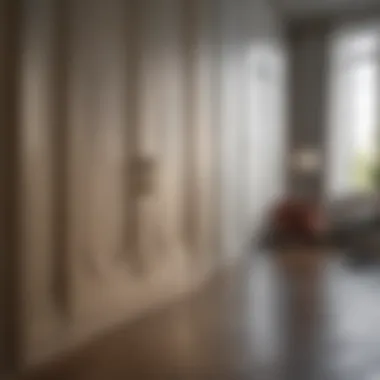
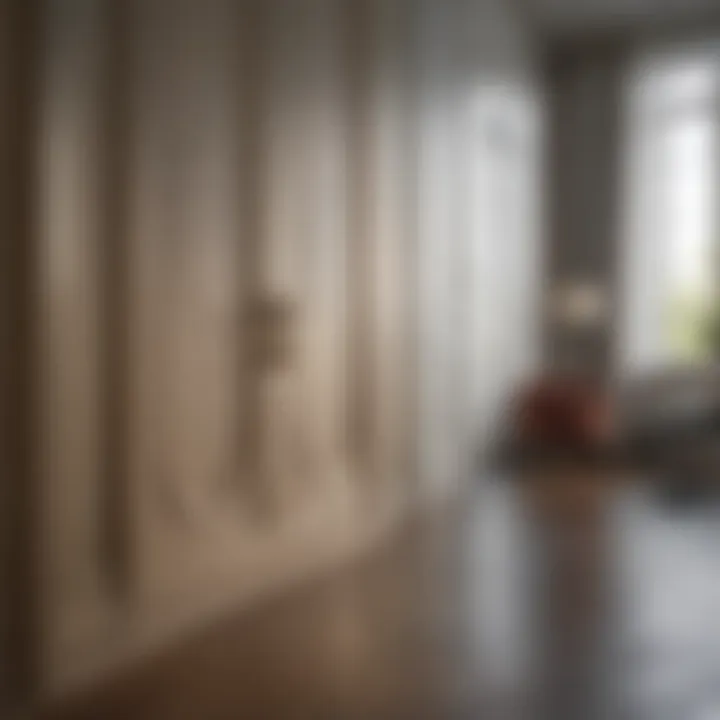
MDF and Composite Materials
MDF, or Medium Density Fiberboard, is an engineered wood product that has gained popularity for its smooth finish and cost-effectiveness. When it comes to bifold doors, MDF offers a practical solution that bridges the gap between aesthetic appeal and budget considerations. Composite materials, often made from a blend of wood particles and synthetic elements, also provide a great alternative.
With both MDF and composites, the foremost advantage is their resistance to warping commonly seen in solid wood. Plus, they accept paints remarkably well, making them a favorite for those wanting bold color choices. However, they can be less robust than solid wood, and if damaged, they may not be as easy to repair.
Key points about MDF and composites include:
- Cost-effective elegance: Offers a similar look to wood without breaking the bank.
- Low maintenance: Generally, these materials require less care over time.
- Sustainability: Many composites use recycled materials, making them a greener choice.
Glass Options
Glass bifold closet doors are an eye-catching choice, transforming an ordinary closet into a visually striking element of the room. With a range of clear, frosted, and tinted glass options, these doors can create an illusion of space and light. They serve well in modern and contemporary designs, giving a sleek and open feel. But before going all in with glass, it’s necessary to consider issues of privacy and potential breakage.
Advantages of glass include:
- Light enhancement: Brightens the space and opens up the room.
- Visual appeal: Can serve as a stunning focal point.
- Easy maintenance: A quick wipe-down usually does the trick for cleaning!
Nonetheless, they may require a sturdier frame due to their weight and require that the glass be tempered for safety.
Metal Characteristics
Metal bifold closet doors introduce a contemporary edge that can redefine a room's atmosphere. Options such as aluminum and steel are frequently used, particularly in industrial-style homes or spaces that require high durability. Metal is particularly resilient against the wear that comes from frequent use, making it a smart long-term investment.
Benefits of metal doors are:
- Durability: Resistant to dents and scratches, making them ideal for busy households.
- Modern aesthetic: Complements minimalist and industrial design themes beautifully.
- Fire-resistant: Provides an added layer of safety in case of emergencies.
However, one must consider insulation as metal can conduct temperature, leading to cold drafts or warmth escaping the closet. Painting metal can also be tricky; a high-quality paint that’s made for metal surfaces will yield the best results.
In summary, when selecting bifold closet doors, it's vital to consider how the chosen material aligns with your lifestyle, the room's design, durability needs, and maintenance capabilities. A thoughtful selection ensures that the final outcome is not only visually pleasing but aligned with your specific requirements.
Design Considerations
When choosing bifold closet doors, design considerations play a pivotal role in marrying functionality with aesthetics. These doors aren’t merely a way to conceal the clutter inside a closet; they can enhance the visual appeal of a room, contributing significantly to the overall interior design scheme. To ensure that you select doors that complement your space, several factors must be taken into account: style compatibility, color selection, and finishing touches.
Style Compatibility
Style compatibility refers to how well the bifold doors align with the existing decor of a room. When selecting these doors, it’s essential to consider the overall theme of your home. Are you leaning towards a modern, minimalistic approach? Perhaps a rustic charm, or maybe something more classic? The bifold door should fit into this narrative seamlessly.
There’s a broad spectrum of styles available. For instance, shaker-style doors suit a traditional setting with their clean lines and simplicity. On the other hand, modern panel designs resonate well in contemporary homes, boasting sleek surfaces and sleek handles. Using a design that matches the rest of your space is crucial, as doors that clash with your theme might overshadow the elegance of the room.
Color Selection
Choosing the right color for bifold doors is like seasoning for a dish; it can either make or break the overall look. Consider the hues already present in your space - walls, flooring, and furnishings all come into play. A lighter color can make a small space feel more expansive, while darker tones can instill a sense of drama or intimacy.
When thinking about color, you might want to browse through trending palettes to catch what’s hot, but don't forget the classics always hold their ground. Neutrals like whites and greys work well, offering versatility. However, a splash of bold color can be invigorating, especially in children’s rooms or creative spaces. Take into account how light interacts with your selected colors, as this can shift the perception throughout the day.
Finishing Touches
The finishing touches are what truly personalize your bifold doors. From the type of hardware used to the final coating, these elements contribute significantly to functionality and appeal.
For example, brushed nickel handles offer durability and a touch of elegance, while a choice of painted finishes can add a layer of personality. Consider if you want classic hinges or a more modern top-hung track, which can be less visible and create a sleeker look. Attention to detail here reflects the overall quality of design in your space.
One should also think about how the doors operate. A smoother glide not only enhances usability but also reflects precision and care in design. Investing in quality finishes can save time and frustration in the long run while elevating the entire space.
The key to a successful design lies in harmonizing the elements and considering how they will interact within the overall space.
Installation Process
Installing bifold closet doors holds significant importance in the scope of this exploration. This part of the article aims to guide homeowners through the crucial steps necessary to ensure a flawless installation. A well-executed installation not only enhances the functionality of your closet but also elevates the overall aesthetic of your space. Poor installation can lead to operational problems down the line, frustrating users and possibly incurring additional costs for repairs. Thus, it’s imperative to approach the installation process with proper tools, a clear strategy, and awareness of common pitfalls.
Tools Required for Installation
Before you dive into the world of bifold door installation, gather the tools you’ll need for a smooth journey:
- Screwdriver: Both flat-head and Phillips types are handy.
- Drill: This will make it easier to create pilot holes and secure the hardware.
- Measuring Tape: Precision in measurement is non-negotiable.
- Level: Ensuring your doors hang straight is vital for visual appeal.
- Hinge Tool: May simplify the alignment of hinges on each bifold panel.
- Pencil: For marking where screws and hinges will go.
- Safety Goggles: Prioritize your safety while using power tools.
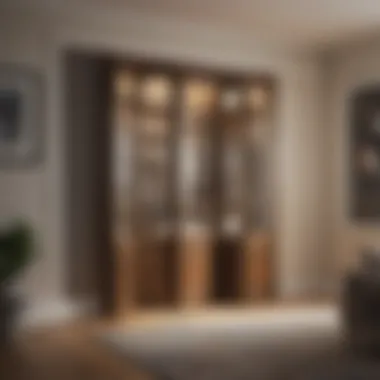
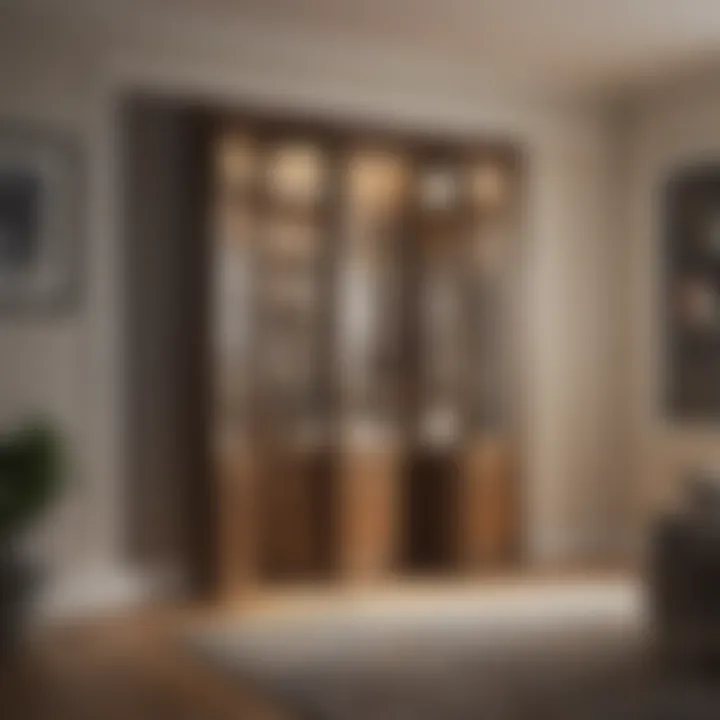
With this toolkit at your side, you're armed to tackle the installation with confidence.
Step-by-Step Guide
Let’s break down the installation process into digestible steps:
- Measure Your Space: Begin with accurate measurements of the doorway where you’ll install the bifold doors. A well-fitted door will have a lasting impact.
- Purchase the Right Doors: Armed with your measurements, procure bifold doors that fit. Seeking assistance from a professional retailer can be beneficial.
- Prepare the Area: Clear the space of any obstructions. A clean environment aids concentration and safety.
- Install The Track: Using your drill, secure the top track in place. Ensure it’s level, or you could end up with crooked doors.
- Attach The Hinges: Once the track is secure, attach the hinges to each door panel. Mark their positions carefully before drilling.
- Hang The Doors: With hinges attached, lift the doors into place on the track. You might need a helper for this part adeptly.
- Secure Bottom Brackets: Finally, install the bottom brackets to keep them in line. Adjust as necessary to align properly.
- Test for Functionality: Glide the doors back and forth a few times to make sure all is well.
This step-by-step guide provides clarity and structure to the process, allowing you, as a homeowner, to feel confidence rather than confusion.
Common Installation Mistakes
As with any project, there are missteps that can trip you up along the way. Being aware of these can save you headache:
- Neglecting Measurements: "Measure twice, cut once" isn’t just a saying; it’s a principle. Double-checking can prevent costly errors.
- Improper Leveling: If the track isn’t level, the doors won’t function smoothly. Take your time here.
- Skipping the Manual: Installation guides are there for a reason. Ignoring them may lead you down the wrong path.
- Wrong Fasteners: Using the wrong screws or fasteners can cause structural weaknesses; make sure you’re following specifications closely.
- Inadequate Support: Failing to secure the top track properly might result in sagging over time. Installing it correctly is not a step to skip.
Being aware of these common pitfalls can be the difference between a successful installation and a frustrating ordeal.
A proper installation process not only provides functionality but also extends the lifespan of bifold doors, making it well worth your while to prepare and execute with care. Remember, the satisfaction in the end result reflects the effort and attention paid to the entire process.
Maintaining Bifold Closet Doors
Maintaining bifold closet doors is not just about preserving their aesthetic charm; it’s also a crucial part of ensuring their longevity and functionality. When you spend money on these doors, be it the wooden or glass variants, it pays off to invest some time in upkeep. Regular maintenance can help avert expensive repairs down the road and enhance your overall living experience. Keeping them in working order means they will slide smoothly, latch securely, and avoid that annoying squeak that can drive you crazy.
Regular Maintenance Tips
First off, let's talk about some down-to-earth maintenance tips. These are as easy as pie and don’t require you to be a DIY whiz:
- Lubrication: Use a silicone or dry lubricant on the tracks every six months. This keeps the doors gliding effortlessly and stops them from sticking. A good squirt in the right spots usually does the trick.
- Cleaning the Tracks: Dust and debris can pile up in the tracks and hinder movement. Make it a habit to vacuum or wipe down the tracks occasionally. A clean environment promotes smooth operation.
- Hinge Checks: Inspect the hinges every few months, too. If you spot rust or wear, consider replacing them. This small check avoids bigger issues down the road.
- Panel Inspection: Look for cracks, chips, or loose panels. Addressing these early can save a lot of hassle later on. Just a bit of glue or touch-up paint can do wonders.
Keeping these tips in mind can serve as a simple and effective guideline, ensuring that your bifold doors remain both functional and stylish.
Repairing Common Issues
Even with routine maintenance, problems can occur. Understanding how to troubleshoot common issues is key to preserving your bifold doors. Here are some typical challenges you might face and how to tackle them:
- Sticking Doors: If your doors are stubborn and refuse to slide, it might be a sign of grime buildup. First, clean the tracks as previously mentioned. If that doesn’t work, check for misalignment; one door might be off-kilter.
- Squeaky Hinges: A common annoyance. If you hear squeaks when opening or closing, it’s time for a little lubrication. Even a drop of WD-40 can eliminate the irritating noise.
- Loose Panels: Over time, the panels might become loose and wobble. For this issue, tighten screws and ensure everything is locked in place. If screws are stripped, investing in new ones could solve the ordeal.
- Broken Tracks: In cases of severe wear, the tracks might need replacement. It can feel daunting, but with tools and a little patience, it’s something you can handle or hire a pro for if you prefer.
Proper maintenance extends the life of your bifold doors, saving you time and money in the long run.
When faced with any challenges, remember that taking a proactive approach to maintenance can help you tackle issues before they escalate. Whether you’re a seasoned homeowner or new to the game, these tips serve as valuable tools in ensuring that your bifold doors not only look great but also continue to operate effectively for many years.
Comparative Analysis with Other Door Types
When selecting doors, many homeowners find themselves at a crossroads. The sheer variety of styles and functionalities can be overwhelming. This section aims to unpack the differences between bifold doors and their close counterparts—sliding doors and standard hinged doors. The insights shared here are intended to guide readers through the pros and cons, helping to align door choices with individual needs and preferences.
Bifold vs. Sliding Doors
Imagine you're standing in your hallway, facing the options. Bifold doors swing open to divide spaces like a friendly handshake, while their sliding counterparts glide silently, making it easier to save space. Each type carries its unique attributes, but understanding the nuances is key.
Key Differences:
- Space Efficiency: Bifold doors fold neatly against one another, requiring less clearance than sliding doors. For homes with tight layouts, this can be vital.
- Ease of Use: Sliding doors are equipped with tracks, making them as slick as ice when it comes to operation. Bifold doors, while simple, require a bit more muscle to fully open due to their hinge system.
- Aesthetic Appeal: Bifold doors often make for a more visually appealing option. They can be designed with intricate patterns and frames, whereas sliding doors usually have a sleek, contemporary look.
"The decision between bifold and sliding doors often boils down to the available space and desired aesthetic."
Many homeowners enjoy bifold doors in closets or as room dividers thanks to their ability to add character while remaining functional. On the flip side, sliding doors can open up expansive views and acts as excellent patio entrances, presenting a seamless transition between indoor and outdoor areas.
Bifold vs. Standard Hinged Doors
Next up, we take a closer look at bifold doors versus the classic standard hinged doors. These traditional doors have stood the test of time, but in a world that's constantly evolving, how do they measure up?
Noteworthy Comparisons:
- Open Space Utilization: Hinged doors swing outward or inward, which means that they can eat up considerable floor space—especially in smaller rooms. Bifold doors, however, can be tucked away, providing an efficient flow without sacrificing functionality.
- Installation Complexity: Installing standard hinged doors typically isn't rocket science; you just need a frame. However, bifold installations can get a bit tricky due to the need for mounting tracks and making sure the folds align properly.
- Cost Considerations: Generally, bifold doors might carry a higher price tag than standard hinged doors, primarily due to their hardware and custom designs available.
Another thing to consider is durability. While bifold doors may include special finishing options for moisture resistance, standard hinged doors can also be made from robust materials to endure everyday wear and tear.
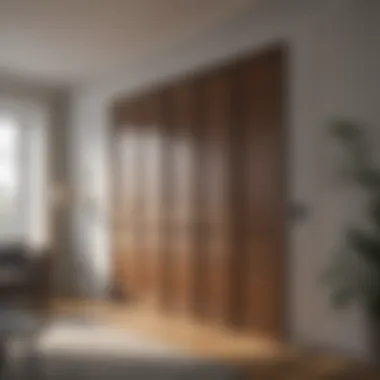
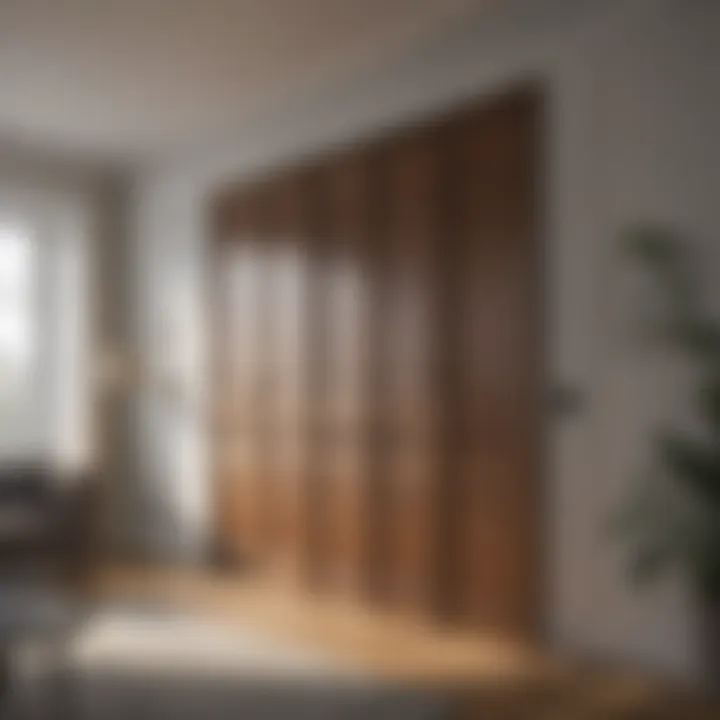
In summary, the analysis doesn't just highlight the functionality and aesthetics of each type; it encapsulates a broader understanding of how each door serves different purposes in varying contexts. Whether one leans towards the modern touch of bifold doors or the classic frame of hinged doors, the essential part is choosing what fits their lifestyle and space best.
Cost Considerations
When it comes to selecting bifold closet doors, it's crucial to weigh the cost factors involved. The expense can differ wildly based on materials, sizes, and additional features. Understanding these costs helps in making informed decisions, particularly for housewives and homeowners who are keen on maximizing value while managing their budgets.
Initial Cost of Purchase
The initial cost of bifold doors is often the first point of consideration for potential buyers. Prices can range from leather-style MDF models to solid wood options that are more luxurious and have a higher price point.
Some key aspects influencing the purchase cost include:
- Material: Solid wood doors generally command a higher price compared to those made of materials like MDF or composite.
- Size: The dimensions—especially the 29.5 x 79 inches variation—also play a role since some custom sizes may come at a premium.
- Style and Design: The more ornate or unique the design, the more you can expect to pay.
- Brand: Renowned brands, like Masonite or Jeld-Wen, may charge more based on reputation and quality assurance.
It’s wise to shop around, compare prices online and in local stores, and even check websites like reddit.com for more insights on reliable brands. Take note of discounts or seasonal sales as well, which can provide significant savings.
Long-term Investment Value
While the initial purchase price is essential, consider how bifold doors serve as an investment over time. Here are some points on how they can offer great long-term value:
- Durability: High-quality bifold doors tend to last longer, which means you might not have to fork out for replacements anytime soon. Some materials, especially well-maintained wood, can be durable for decades.
- Aesthetic Appeal: A classy set of bifold doors can enhance the overall appeal of a room, adding value if you ever decide to sell your home. Moreover, a pleasant design can positively impact daily living - more visual pleasure every time you walk by.
- Energy Efficiency: If you opt for insulated or high-performance materials, you might see a decrease in heating or cooling costs over time. These savings can add up, making your investment even more worthwhile in the long run.
"Investing in quality bifold doors is not just about immediate costs. It’s about considering their durability, energy efficiency, and potential increase in home value."
In summary, being mindful of both initial and long-term costs is imperative. Balancing the desire for quality with the realities of one’s budget helps avoid splurging on features that may not add significant value or functionality. Proper planning and research go a long way in ensuring that stakeholders can enjoy their bifold closet doors for years to come.
Sustainability and Environmental Impact
The emphasis on sustainability in today's world extends to nearly every aspect of our lives, including the materials and designs we choose for our homes. Bifold closet doors, while serving a functional purpose, also play a crucial role in promoting environmentally friendly practices. In this section, we will explore how selecting sustainable materials and techniques contributes to a more eco-conscious lifestyle, particularly when it comes to bifold doors.
Eco-friendly Material Options
When considering bifold closet doors, it's vital to examine the materials from which they are made. Opting for eco-friendly materials not only reduces environmental impact but also contributes to healthier indoor air quality. Here are some materials to keep in mind:
- Reclaimed Wood: Reusing wood reduces deforestation and gives new life to materials that would otherwise be discarded. This option often boasts unique aesthetics that can add character to your space.
- Bamboo: Fast-growing and renewable, bamboo is a sustainable alternative to traditional timber. Its durability and natural beauty make it an attractive choice for bifold doors.
- MDF from Recycled Resources: Medium-density fiberboard, when made from recycled wood fibers, is an environmentally friendly option as it maximizes resource use and minimizes waste.
- Low-VOC Finishes: Choosing finishes that are free from volatile organic compounds ensures a healthier living environment and reduced air pollution.
By selecting these eco-friendly materials, homeowners can contribute to a greener future, one door at a time.
Energy Efficiency Considerations
When it comes to sustainability, energy efficiency is key. Bifold doors can significantly influence the energy consumption of a home, especially when they provide access to closets that house heating or cooling systems. Here are a few points to ponder on this topic:
- Insulation Quality: Look for bifold doors that come with good insulation properties. Energy-efficient doors reduce heat loss in winter and keep the cool air in during summer. This helps in lowering energy bills and reducing environmental footprints.
- Seals and Gaskets: Opt for designs with effective sealing mechanisms. High-quality seals prevent air leaks, making it easier to maintain temperature inside the home, thereby improving overall energy efficiency.
- Sunlight Consideration: Strategic placement and design can leverage natural light, reducing the necessity for artificial lighting. Using high-performance glazing on bifold doors allows homeowners to enjoy sunlight while maintaining thermal efficiency.
In a nutshell, being mindful of energy efficiency when selecting bifold closet doors not only benefits the environment but can lead to substantial savings on utility bills.
"Making conscious choices today can lead to a sustainable and environmentally friendly future tomorrow."
By integrating eco-friendly materials and energy-efficient designs in bifold closet doors, homeowners can contribute positively not just to their living spaces, but to the planet at large.
Future Trends in Bifold Closet Door Design
The field of interior design constantly shifts as technology and aesthetics evolve. Understanding the future trends in bifold closet door design is essential for homeowners looking to enhance the functionality and visual appeal of their spaces. As spaces become more integrated and technology-savvy, the doors we use are no exception to these advancements. Integrating these trends offers both practical benefits and a touch of modern elegance to homes.
Smart Technology Integration
Incorporating smart technology into bifold closet doors isn't just a futuristic concept; it’s quickly becoming a norm. Imagine opening your bifold doors with a simple voice command through a smart assistant, like Amazon's Alexa or Google Assistant. This isn’t science fiction—it’s happening now. Smart locks and sensors allow homeowners to monitor the status of their closets while providing additional security.
- Convenience: Smart technology can streamline daily routines, making it easier for busy families to access their belongings.
- Energy Efficiency: There are designs that incorporate energy-efficient features, like sensors that can detect when doors are left open, potentially tying into a home’s energy management system.
- Accessibility Features: Smart automated doors offer solutions for those with mobility challenges, ensuring everyone can easily access their items.
The integration of smart technology maximizes both usability and security, reshaping our interaction with storage spaces.
Innovative Design Concepts
As design continues to evolve, innovative concepts transform the way bifold closet doors are perceived. A growing trend is to use bifold doors not just for practical purposes but as stunning focal points within a room. Some noteworthy trends include:
- Mixed Materials: Designers are experimenting with various combinations of materials, such as wood and metal or wood and glass, to create eye-catching contrasts.
- Custom Finishes: Instead of standard colors, custom finishes like matte, gloss, or even textured surfaces open up a myriad of styling options. For example, a textured wood finish can enhance a rustic theme, while a sleek glass design complements a modern aesthetic.
- Artistic Integrations: Some homeowners are opting for artistic doors that serve as canvases. Think of a door featuring a mural or modern art, which can change the narrative of a space entirely.
Innovative design concepts allow for greater personal expression and reflection of individual aesthetics, transforming rooms from merely utilitarian to masterfully curated spaces.
"Bifold closet doors are not just access points; they are opportunities to elevate your space."
As the exploration of these trends continues, it’s clear that the future holds exciting possibilities for bifold closet doors that blend technology and personalized design, making them a vital aspect of modern home improvement.







